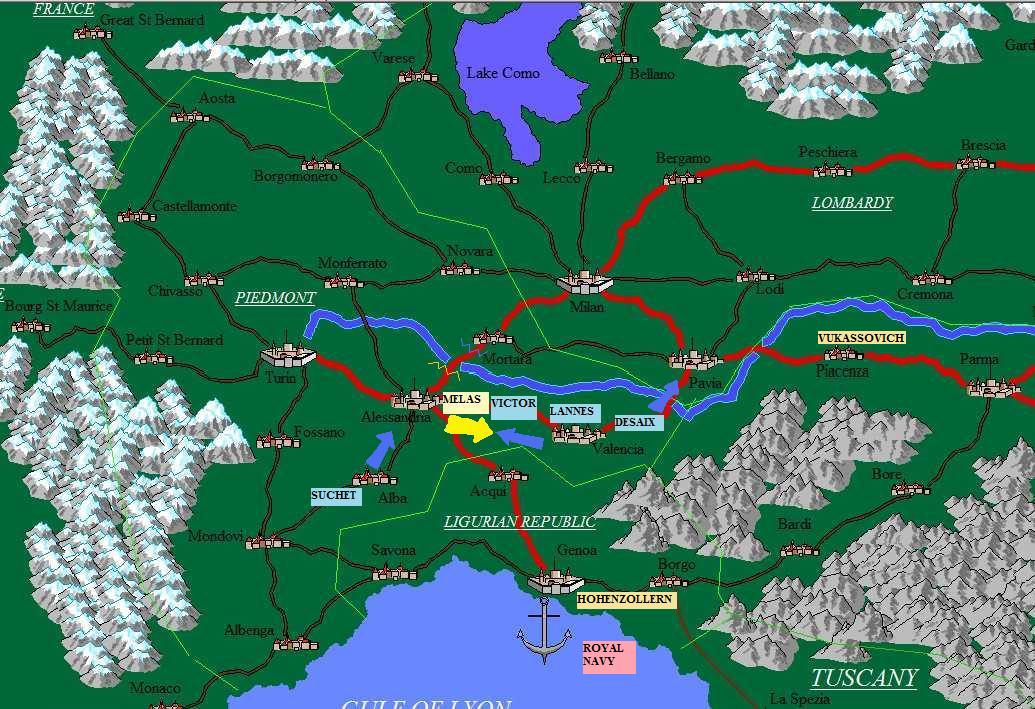
MARENGO AFTER ACTION REPORT
| It is 1800 and the Austrians under General Melas have been rampant
in Italy, reconquering everything that the French had won in the
previous campaign of 1797. Indeed, they had gotten so far as to be
besieging General Massena in Genoa. General Suchet had few French forces
southwest of Genoa to prevent an Austrian attack on France if Genoa
fell.
In May though, First Consul Bonaparte has led the Army of the Reserve
over the difficult Pass of Great St Bernard and fell upon the Austrian
supply lines. After a series of actions, the French had secured Milan
and Pavia. Bonaparte was pushing toward Piacenza but his command was
being spread out. |

| Bonaparte has hurriedly begun to recall his Corps to hurry to Victor's aide but it may be too late. |
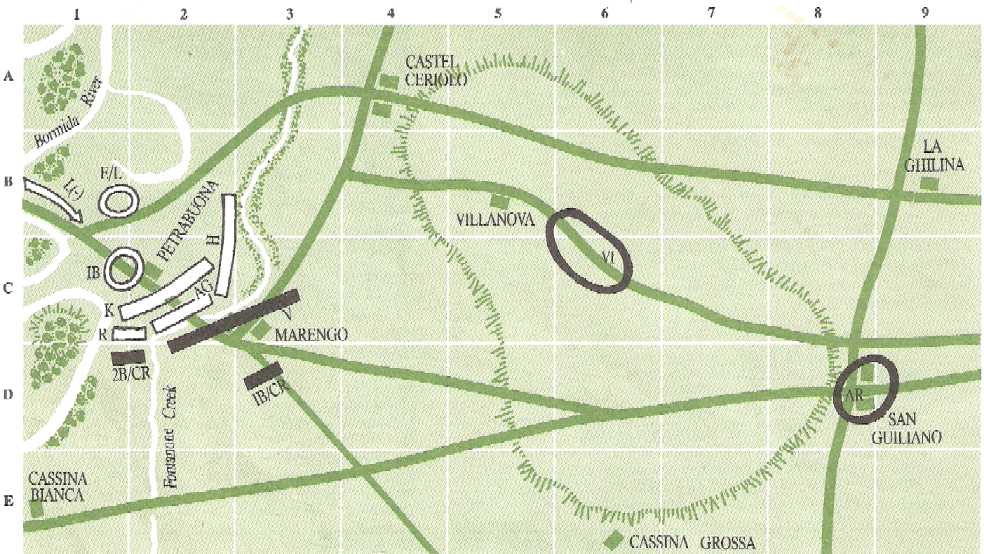
| 1000 HRS: On initial deployment, The Austrians are pushing forward toward Marengo village where Victor holds. There are a lot more Austrians than Victor can hope to handle. Lannes is hurrying forward but the entire left wing of the Austrian army is bearing down on him. |
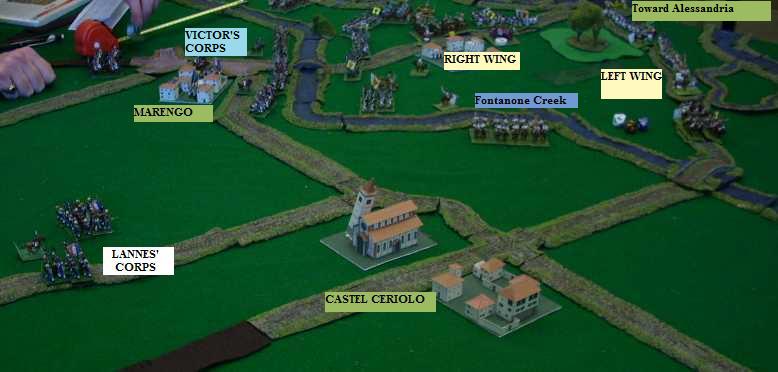
| The Fontanone creek (right) is a serious obstacle and Marengo village (below) may also be a tough nut. |
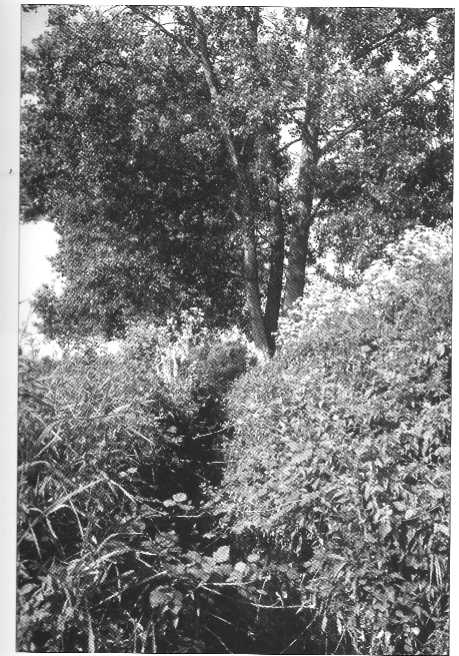 |
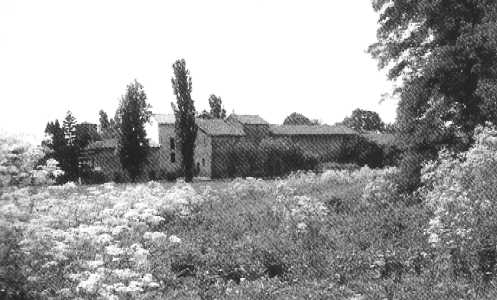 |
| Murat is not initially well deployed with his heavy cavalry being too distant to properly command. O'Reilly will quickly throw the French dragoons back across the creek and they will be happy to do so. |

| The initial advance against Marengo is done in the traditional Austrian manner: cautious and patient. The Left Wing snakes forward and will begin to deploy into battle formations once they are across the bridge. |
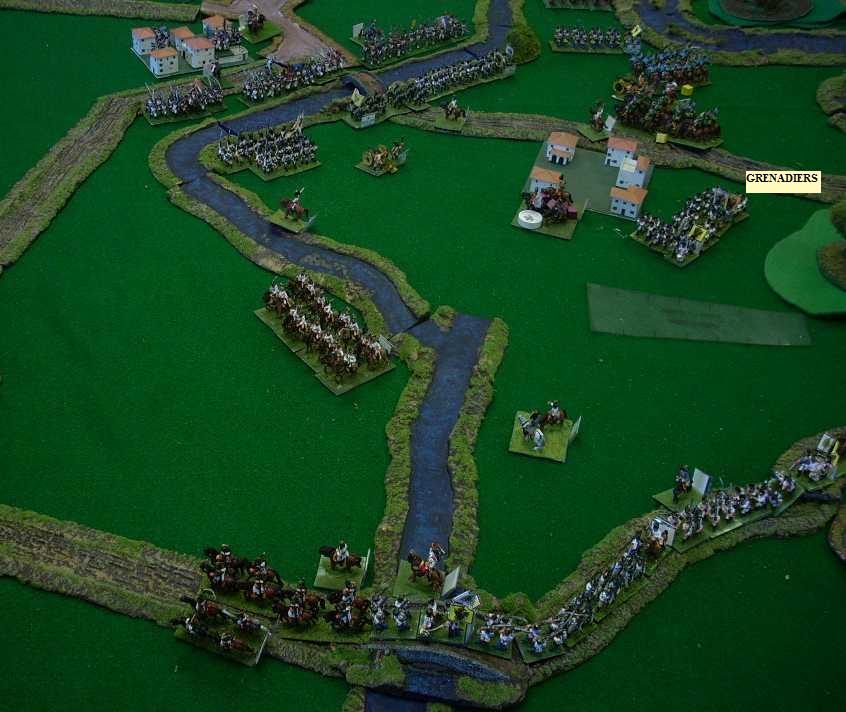
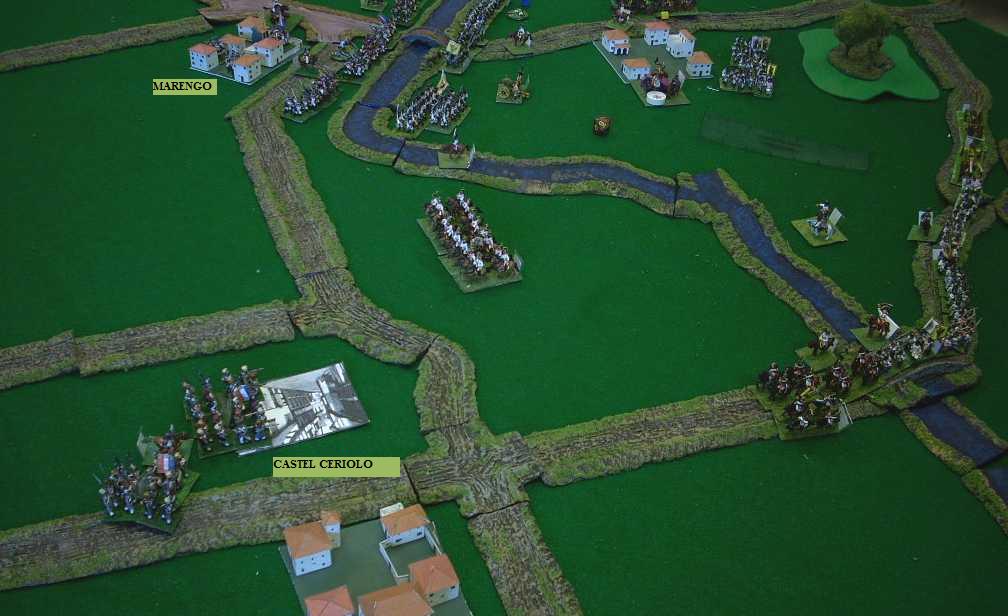
| The Austrian's begin a double envelopment of the forward French positions before Marengo. |
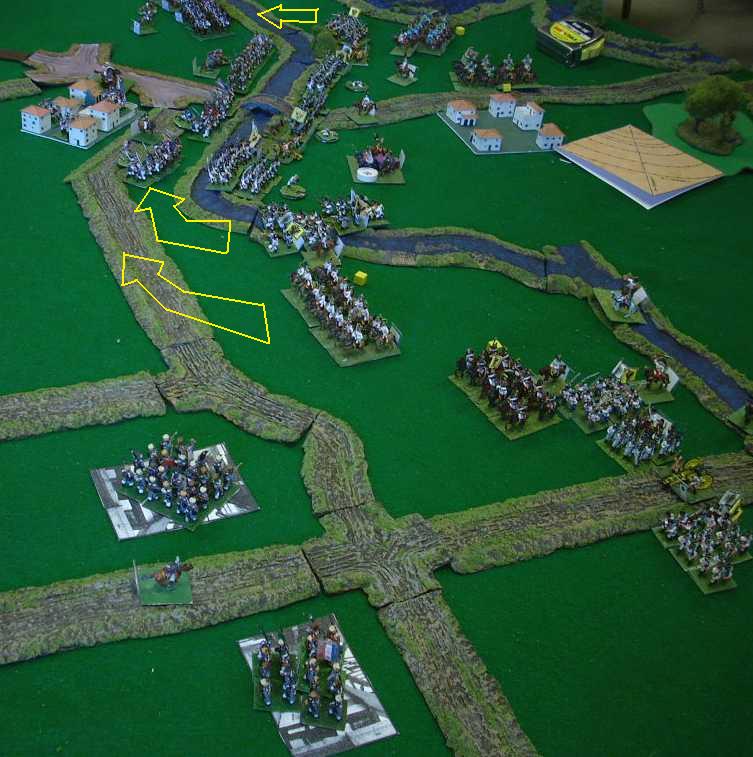
| 1200 Hrs: When the French see an opportunity to counterattack an Austrian column as it crosses the Fontenone, they charge in with the bayonet but fail to get a decisive result, only driving them back to the far bank. That brigade would end up crossing and recross the creek three times throughout the day. Behind Marengo village can be seen the first French infantry to be routed by fire from the jager and artillery. Those infantry that had been deployed in the village are thrown forward to plug the gap. |
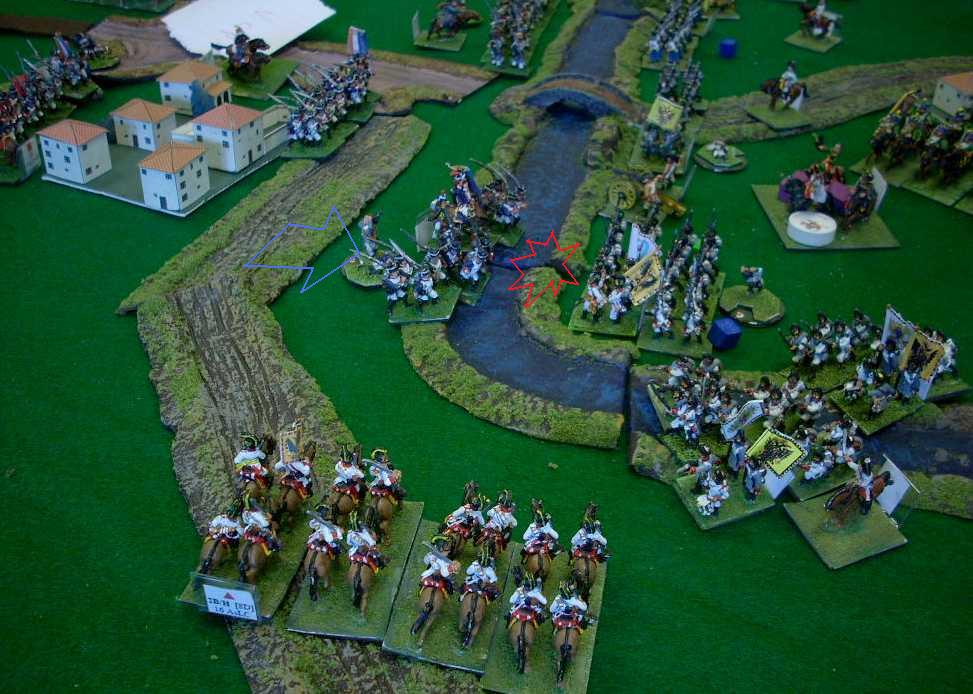
| 1300 hrs: While General Ott deploys his Left Wing into line of battle, Lannes detaches a few battalions to hold Castel Ceriolo and then begins to back his columns up as quickly as he can toward Villanova. When Bonaparte spies the Austrian Grenadiers and Hadik's divisions pouring across the creek in the center, he sees a possible catastrophe. The Austrians have an opportunity to split the French and destroy Victor's isolated corps. A courier is sent to Victor telling him to fell back as quickly as possible. |
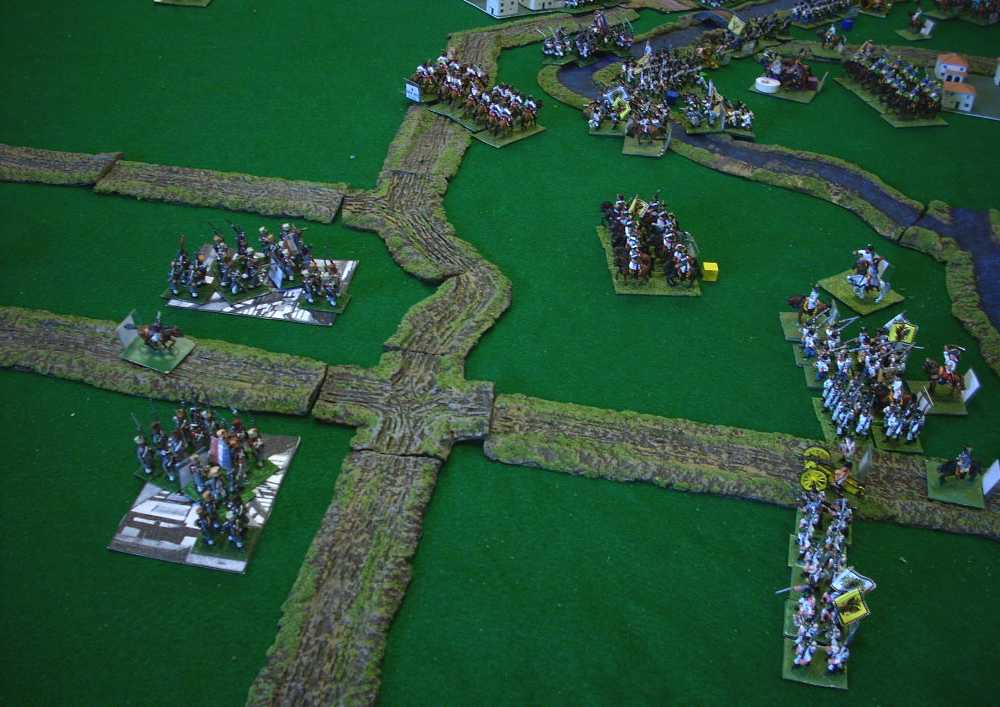
| There is a brief sigh of relief from the French command as the Austrians that are across in the center swing right and march back on Marengo. One Grenadier brigade makes the mistake of attacking the French lines in column and is hurled back. Once it is rallied, thos grenadiers will be switched to the Left Wing. Ott advances in line to carefully, cautiously remove Lannes' rearguard. |
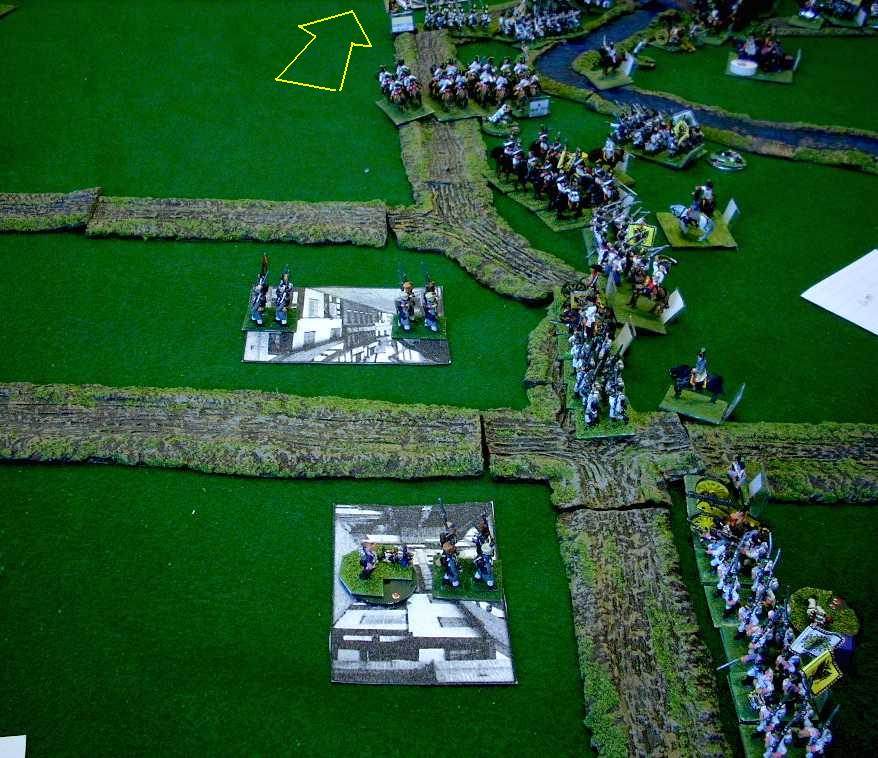
| Victor's position is becoming untenable. He has yet to receive the First Consul's orders to retire but may be obliged to do so anyway as O'Reilly flanks his position. Murat pulls back to keep his cavalry intact and try to close the gap in the center. |
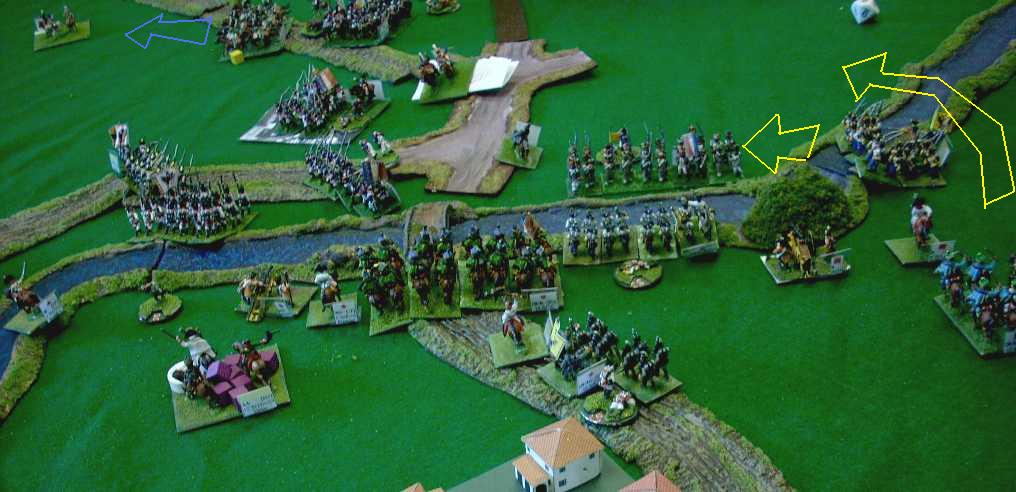
| 1500 hrs: The Austrians break out. Victor's corps is in full retreat, leaving only a single battered brigade in Marengo. Victor and Bonaparte are in consultation together. |
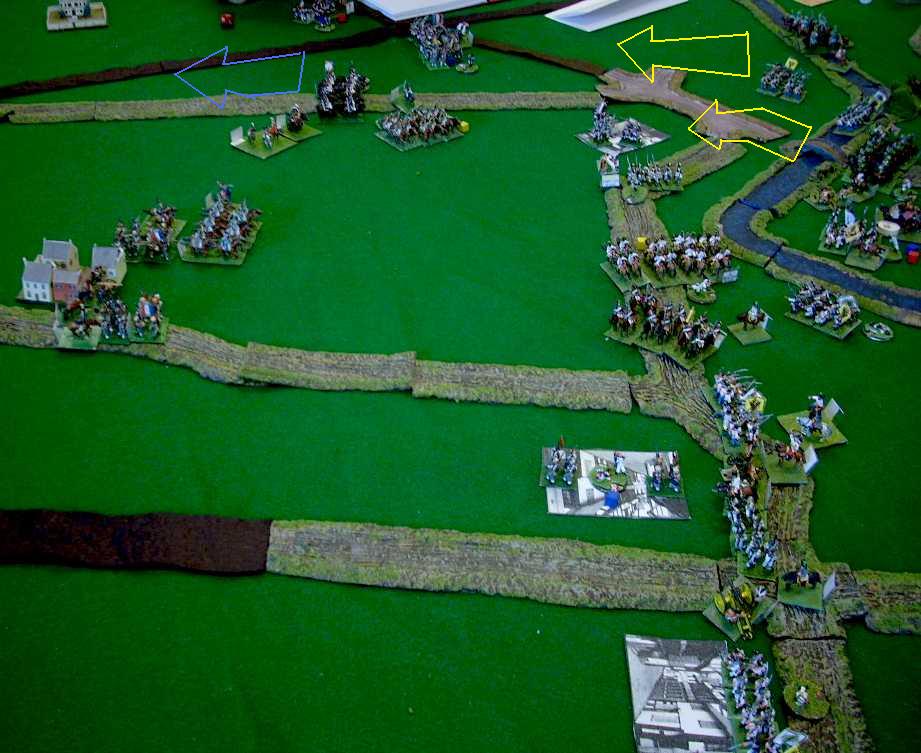
| The Austrians are free to cross the Fontanone creek but their success has been costly and they must spend some time and energy reconstituting their attack. Furthermore, Marengo remains in French hands. For the next few hours, the Austrians would fire on the village and bring up more formations to do a wholesale assault against it. |
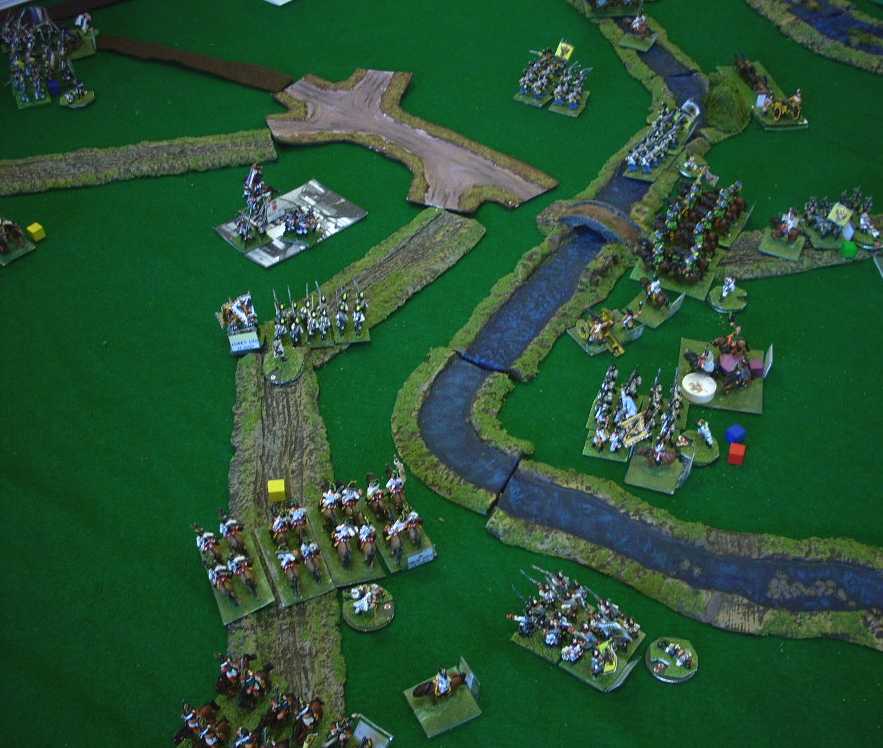
| 1600 Hrs: The French have formed a new line between Cassina Grossa and Villanova. Murat's cavalry is still pulling back but Rivaud, the first elements of Desaix's corps have arrived to add support to Lannes. |
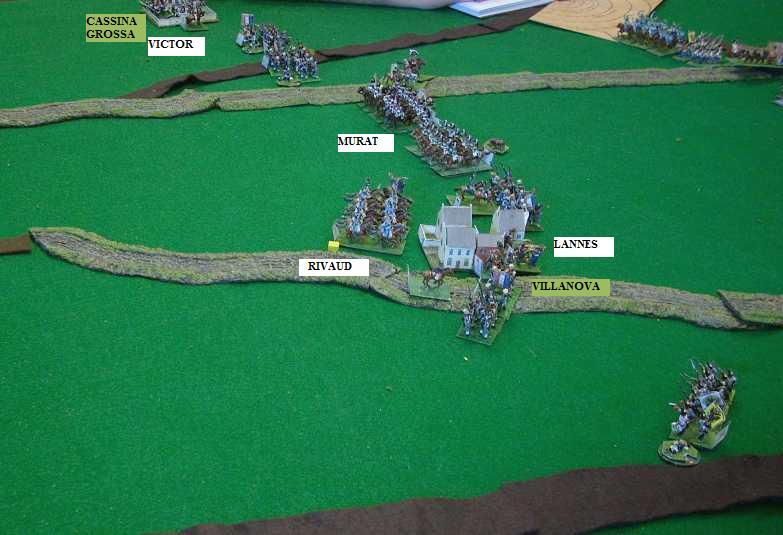
| 1700 hrs: Ott presses his attack on his
objectives. He knows that his troops dare not risk manoeuvring in
columns so he advances slowly in lines. The opposing cavalry of Elsnitz
and Rivaud would shift and manoeuvre against one another without ever
committing. The leading elements of Desaix' Corps have arrived to
bolster the French right.
The French heavy artillery battery at Villanova would manage a decisive barrage to disorder the grenadiers and then when the 1st Hussars charged down on them, the Grenadiers would throw them back. Overall though, General Ott's troops would have a hard time against Lannes and eventually be obliged to retire when they see Desaix' fresh brigades deploying into columns. The Austrian left wing would fall back to Castel Ceriolo and settle into a defensive posture. Lannes would be too battered to be able to attack them though. |
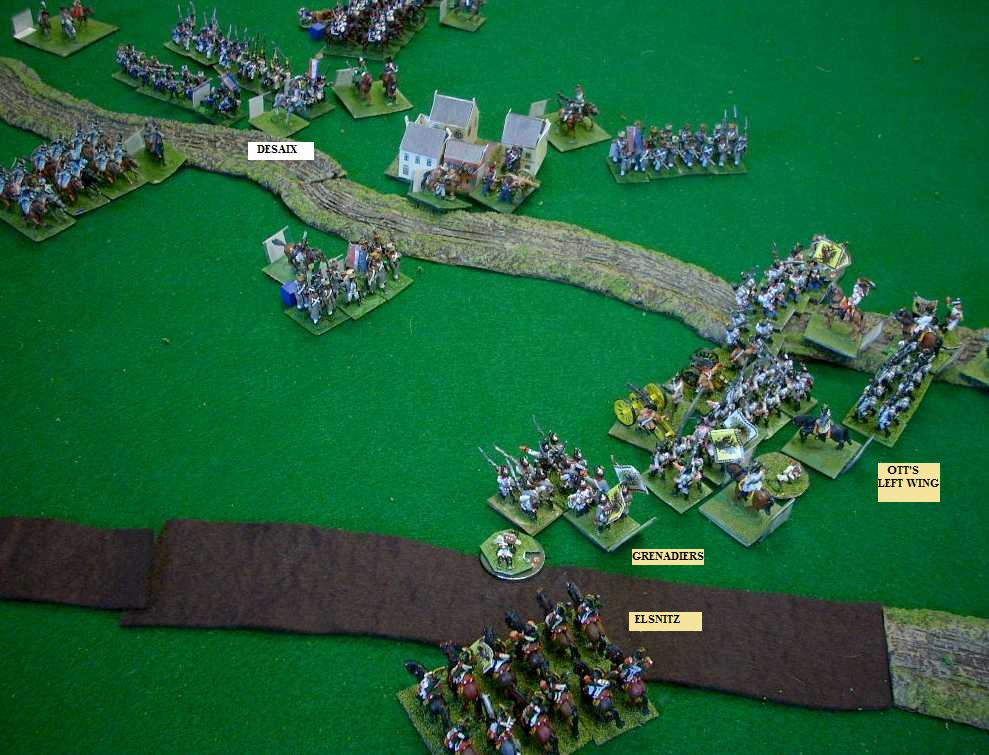
| 1800 hrs: The Austrian right makes a final push on Marengo village. They will take it but it will result in Hadik's infantry once more routing and the grenadiers would be too exhausted to take further part in the battle. O'Reilly is well advanced but waits for the rest of the Austrian right to finish up with Marengo. |
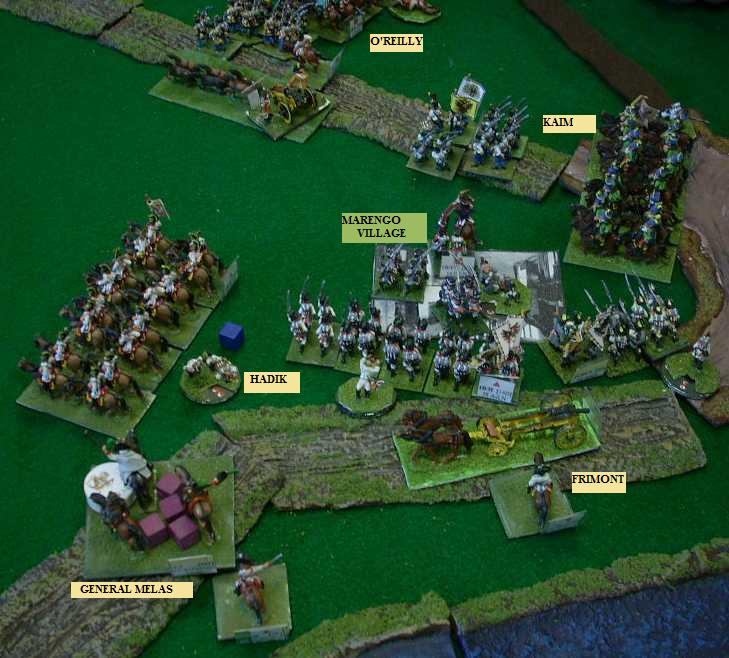
| 1830 hrs: Bonaparte launches an all-out attack against the Austrian right. Though the units of Victor's Corps are near exhausted, they surge forward in the general advance to contribute. Austrian cavalry would be routed by infantry fire and the advance of Desaix obliges General Melas to scurry to safety behind O'Reilly's division. |
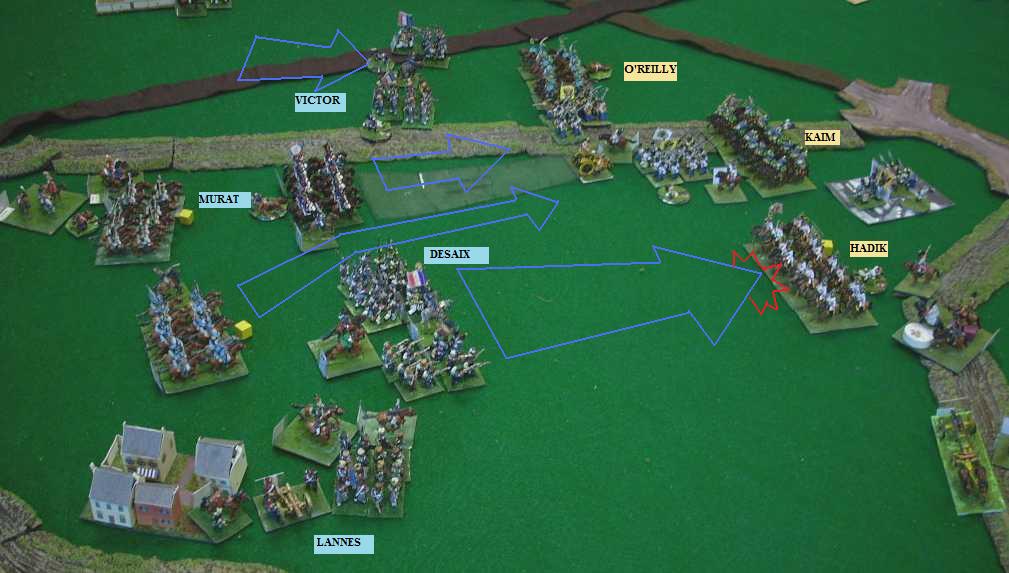
| The Left wing remains quiet while the French attack presses the right to breaking point. |
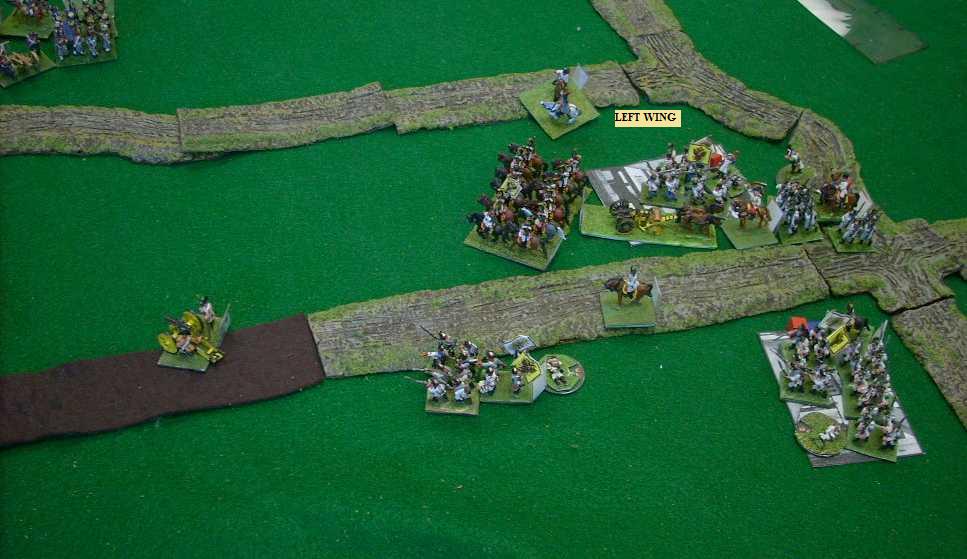
| 1900 hrs: Desaix has bypassed the last of Kaim's brigades and is pressing decisively against O'Reilly that Austrian general frantically tries to rally his men. Victor's Corps and Murat's cavalry would become fatigued by this last push but the Austrians appear shattered beyond recovery. |
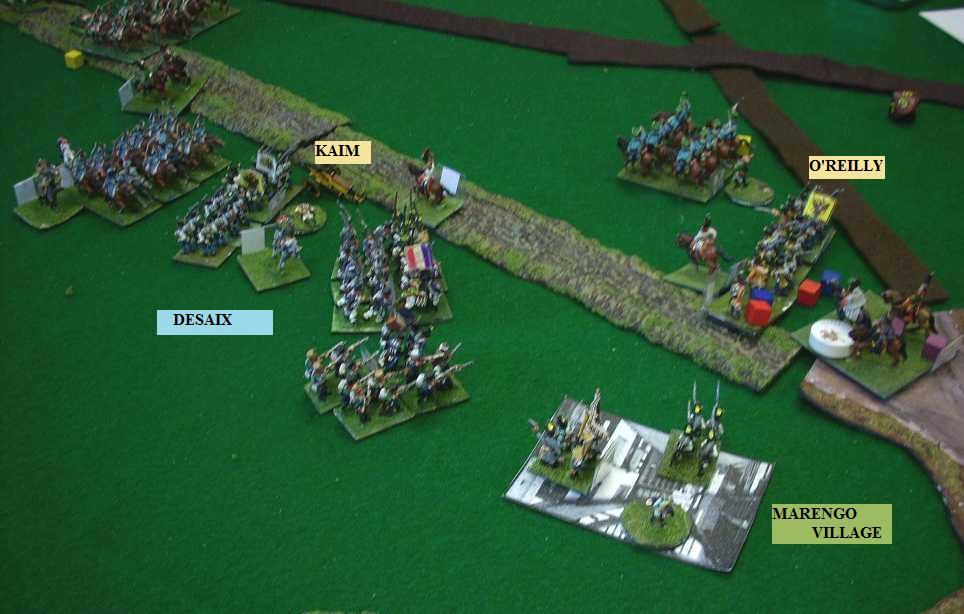
| 1930 hrs: As the battle ends, the Austrian left wing remains in control of Castel Ceriolo but they will abandon it in the night, retreating back to Alessandria. |
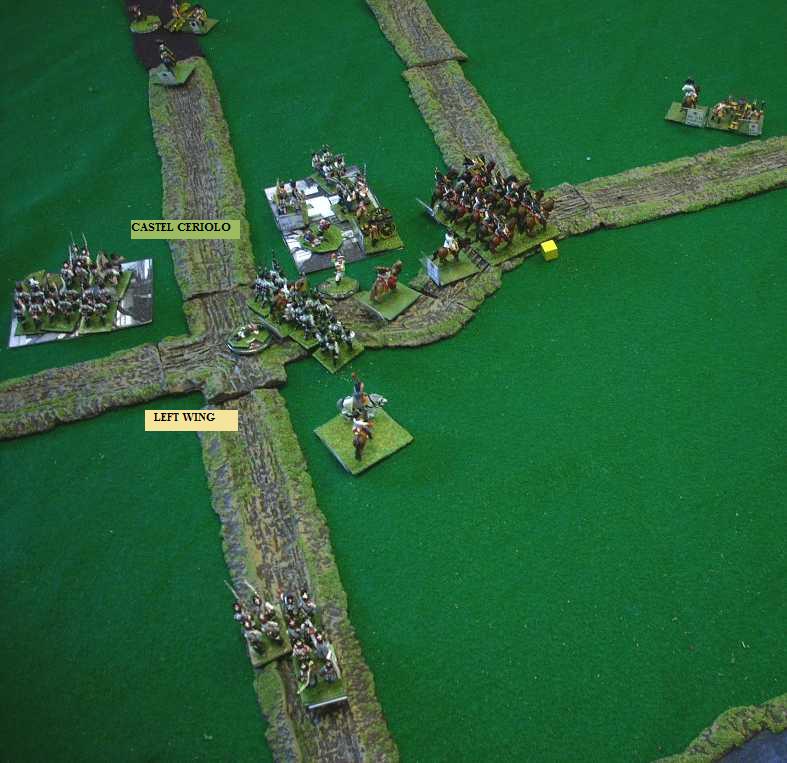
| The battle ends as a decisive French Victory. Though the Austrian army is not broken, almost all of their remaining brigades are unable to continue the fight. Two more brigades of Desaix have arrived on the scene behind Murat, including the Consular guard, and the Austrians have no answer for these fresh troops. |
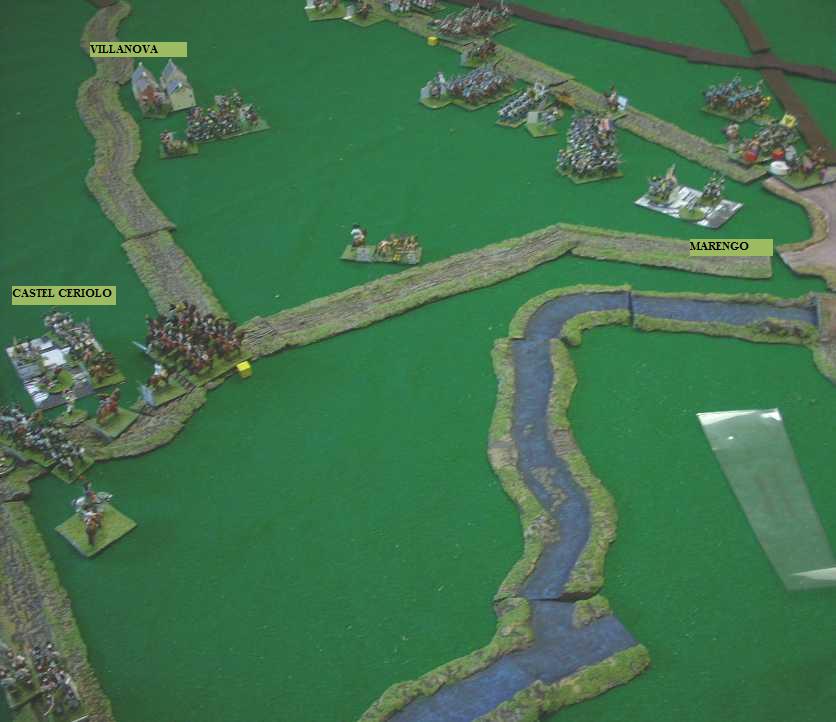
| The end result was almost a mirror of the
historical result and, I believe, for the same reasons. The Austrians on
the Left Wing could not attack quickly enough to prevent the French from
falling back in good order. At Marengo, the Austrians failed to act
decisively when Victor's Corps was hurled back and instead of pursuing
it, paused to spend several hours mopping up the village stronghold. At the moment when Hadik and the Grenadiers were across the Pordenone, I was certain that the French were doomed. We had no answer if they had pushed forward to split us. The critical problem for the Austrians in this battle is how poor their troops are in column. It obliges them to only want to fight in line and that means advancing slowly. It saps their aggressiveness. Because the infantry is advancing at a slow and orderly pace, their cavalry feels obliged to remain with it. When the battle should have turned into a pursuit, the nature of the Austrian army discouraged them for switching to that mindset. |